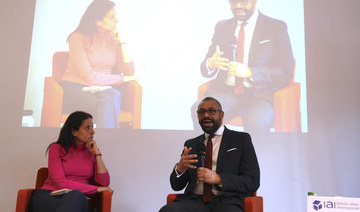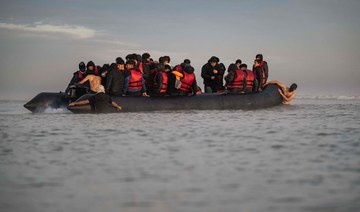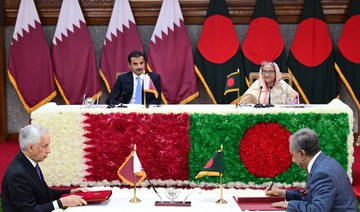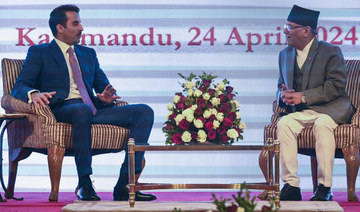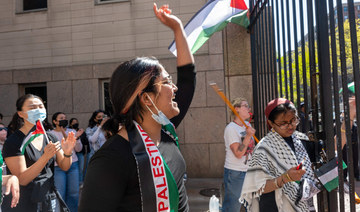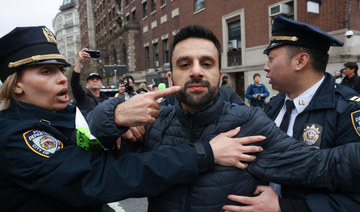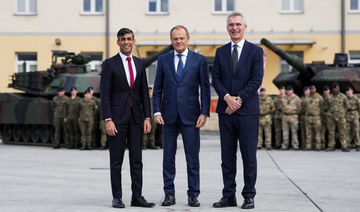CLAVIERE: When suicide attackers and gunmen massacred crowds flocking to Kabul’s airport, they also severed the escape route that Ali Rezaie hoped would take him to a new life abroad, far from the Taliban and their suspicions of well-educated, middle-class people who worked with foreigners in Afghanistan.
In the chaos, Rezaie couldn’t reach the airport where flight after flight took off without him. The 27-year-old was left with no choice but to take his future into his own leathery hands. Like many other Afghans, he resolved to find another way out and embarked on a forbidding journey of thousands of kilometers to Europe, large parts of it on foot.
More than three months later, Rezaie’s odyssey through five countries has carried him high into the French-Italian Alps, where he is pushing through knee-deep snow to evade border guards, with a journalist from The Associated Press in tow.
The Afghan exodus that some feared would flood Europe with migrants after the Taliban swept to power hasn’t materialized. And amid the toothy Alpine crags bristling with icicles, it quickly becomes apparent why: Only the hardiest, most driven and most resourceful exiles make it this far.
Ahead of Rezaie in the snowscape is the French border, unmarked but guarded around the clock by police who peer through thermal binoculars for heat signatures. Rezaie’s companion, another Afghan bearing scars from a suicide bombing that prompted him to flee, had already tried — and failed — to reach France via this wintry route.
So the Afghans advance carefully. They pause to listen for sounds in the frozen silence, to consult a map on Rezaie’s phone before the chill kills its battery and to munch on jam-filled croissants they bought in the frontier village of Claviere in Italy. If caught by French guards patrolling the border on foot, ski-bikes and in vans, Italy is where they’ll be forced to return.
The Taliban takeover and the swift collapse of Afghanistan’s economy has sent people streaming illegally into neighboring Iran, which is often the first stepping stone for Afghans — including Rezaie — who push on into the European Union.
Afghans are now on course to overtake Syrians as Europe’s leading asylum-seekers in 2021. Internal EU reporting on migration trends shows that more than 80,000 Afghans applied for asylum through November. That’s a surge of 96 percent over the same span last year, and the increase was partly driven by the evacuations from Kabul airport.
Rezaie, from Herat in western Afghanistan, says he traveled to Kabul in search of a flight but then doubled back after the suicide bomb and gun attack in the waning days of the airlift. He believes he would have been killed had he stayed in Afghanistan because of work he did with foreign aid groups.
So he emptied out his savings, borrowed money and left behind his printing company, friends and comfortable life.
The quest took him first to Iran and Turkey, then onward by boat and for 25 days on foot into Greece. Next came Italy and then the French border.
Rezaie figures that crossing it will be easy, compared to all he’s been through. But it’s easier still for the European vacationers he suddenly encounters on a ski run that crosses his mountain path. They zoom past, paying him no heed, not having to worry about police patrols.
Feeling conspicuous on the manicured slope, Rezaie is struck by how sharply their carefree joy contrasts with his urgent need to get back in the camouflage of trees.
“Some people go down happy,” he says, lungs heaving in the thin air. “Other people go up sad.”
By finding paths deep into Europe, Rezaie and other migrants offer hope to those sure to follow. Their knowledge about the obstacles, their contacts and their travel tips will trickle back to Afghanistan. Migrants attempting the Alpine crossing share phone maps with GPS markers pointing the way.
Rezaie is aiming for the fortified French town of Briancon. Sayed and Mortaza, cousins and both 16, passed through Briancon hours earlier. They, too, fled in the days after Kabul fell and traveled through Iran to Turkey. From there, they were smuggled aboard a cramped boat to Italy, a brutal six-day voyage that left them too weak to stand.
Caught at the French border, they were allowed to continue because they are minors. Seven adult Afghans they crossed with were sent back.
The Taliban takeover scattered Sayed’s family. His father and older brother worked as police officers. They’ve fled, and Sayed thinks they’re hiding in Pakistan. Without their salaries, Sayed and his mother had no income, so they left, too. She is staying with a sister in Iran. He’s aiming for Germany.
“Maybe Dortmund, because I like Dortmund football club,” he said. “We just want to escape.”
Others who left long before the Taliban takeover say they no longer hope to return.
“It’s finished for us now, for everyone who is in Europe,” said Abdul Almazai, 26, who left Afghanistan as a teenager. Turned away at the French border with eight other Afghans, he planned to try again.
“We have crossed so many mountains,” he said. “I have to make my future.”
Aid workers worry that Afghans more accustomed to mountains and winter’s perils are taking riskier routes through the snow than migrants from warmer climes.
“They are confident, and sometimes being confident is not helpful,” said Luca Guglielmetto, a volunteer worker at a refuge on the Italian side that equips migrants with warm clothes and boots for the crossing.
With darkness falling, the battery on Rezaie’s phone dies. He and his companion forge on through the snow.
Rare are those who manage to cross on their first attempt. Rezaie pulled off that feat and glowed with pride the next morning as he tucked into breakfast at a refuge for migrants in Briancon.
He sent a video of himself wading through snow to his mother and brother in Iran.
He has his sights set on Germany. But he hopes one day to go home.
“I had a car. I had a job, work.” he said. “I had a good life.”
Afghans push through snowy Alps toward new lives in Europe
https://arab.news/9scmm
Afghans push through snowy Alps toward new lives in Europe

- Afghans are now on course to overtake Syrians as Europe’s leading asylum-seekers in 2021
Germany charges six suspected Daesh-K members over attack plots
They intended to carry out high-profile attacks in Germany and Western Europe
BERLIN: Germany has charged six foreign nationals for allegedly plotting terrorist attacks on behalf of the Daesh Province of Khorasan (Daesh-K), the federal prosecutor’s office said on Wednesday.
The suspects, identified as Tajik citizens Mukhammadshujo A., Nuriddin K., Shamshud N., Said S., Raboni Z., and Kyrgyz citizen Abrorjon K., are charged with founding a terrorist organization, among other things.
They intended to carry out high-profile attacks in Germany and Western Europe but had no concrete plan when law enforcement intervened, according to the statement.
The suspects, who were arrested in July last year, had been in touch with Daesh-K, the Afghan offshoot of Daesh, which claimed responsibility for a mass shooting in Moscow last month in which at least 137 people were killed.
According to investigators, the suspects arrived in Germany via Ukraine after war broke out there in spring 2022, and formed a terrorist cell together with another member from the Netherlands.
They met regularly to discuss their intentions and scouted potential locations in Germany, the prosecutors’ statement said.
UK police arrest three over migrants’ deaths in Channel
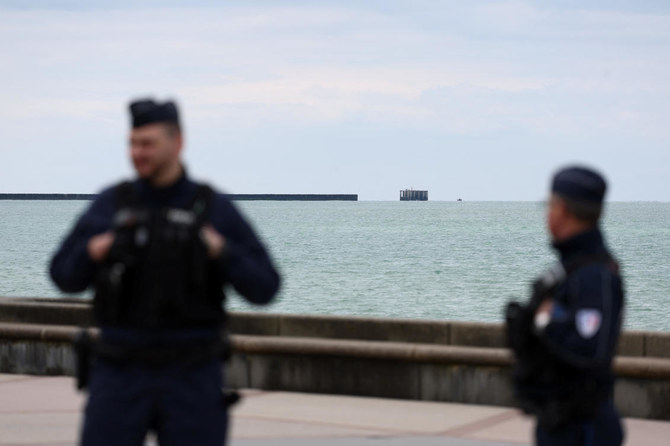
- The men, two Sudanese nationals aged 22 and 19, and a South Sudan national aged 22, were detained
- Suspects were arrested on suspicion of facilitating illegal immigration and entering the UK illegally
LONDON: British police said on Wednesday they had arrested three men over the deaths of five migrants including a child who drowned attempting to cross the Channel from France the day before.
The men, two Sudanese nationals aged 22 and 19, and a South Sudan national aged 22, were detained on Tuesday night, the National Crime Agency (NCA) said.
They were arrested on suspicion of facilitating illegal immigration and entering the UK illegally.
“This tragic incident once again demonstrates the threat to life posed by these crossings and bring into focus why it is so important to target the criminal gangs involved in organizing them,” said NCA Deputy Director of investigations Craig Turner.
New agreement to safeguard rights of Bangladeshi workers in Qatar
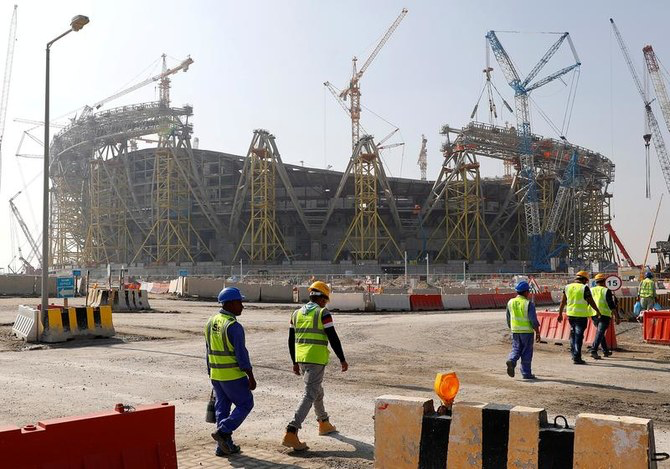
- 350,000 Bangladeshis are employed in Qatar, mostly in construction sector
- MoU signed during Sheikh Tamim bin Hamad Al-Thani’s visit to Dhaka this week
Dhaka: A new agreement between Qatar and Bangladesh includes commitments to establish protections for migrant workers, a top official said on Wednesday, as the Gulf state has been under harsh criticism over failing to safeguard the rights of laborers who constructed its 2022 FIFA World Cup infrastructure.
Migrant workers from South Asia, especially Bangladesh and Nepal, were indispensable to Qatar as it prepared to host the world’s biggest football event, and have been an important part of its economy. Some 350,000 Bangladeshis are employed by Qatar’s government, semi-government and private sector.
The jobs have enabled them to send remittances back home to their families, but many have reported contract violations and illnesses linked to unsafe working conditions. The problems entered the spotlight between 2010, when FIFA granted Qatar the World Cup, and 2022, when the event took place.
During the decade, seven new stadiums, an airport expansion, a new metro and hotels were constructed by 30,000 foreign laborers, according to the Qatari government. Rights groups and investigative journalists have estimated that more than 6,000 of them died in work-related deaths.
A new memorandum on Bangladeshi migrant workers — 80 percent of whom are employed in Qatar’s construction industry — was signed this week as Qatar’s emir, Sheikh Tamim bin Hamad Al-Thani, visited Dhaka.
“A joint working group will be formed for solving labor rights issues,” Khairul Alam, additional secretary at Bangladesh’s Ministry of Expatriates Welfare and Overseas Employment, told Arab News.
“Our Ministry of Expatriates Welfare and Overseas Employment will lead the joint working group from the Bangladeshi side.”
The agreement commits the Qatari and Bangladeshi sides to discuss “ways to develop legislation relevant to areas of labor” and includes plans for a review to ensure that worker rights are in place.
“Labor rights protection, safety and healthy environment issues have also been emphasized in the MoU, and mentioned several times,” Alam said.
“The agreement also said that in case of any issues regarding migrants both countries will sit together and solve the issues amicably.”
The signing of the agreement was welcomed by the Migration Program and Youth Initiatives of BRAC — Bangladesh’s largest development organization, which estimated that more than 1,300 workers from the country died in Qatar during the World Cup construction spree, with many deaths attributed to heart attacks.
“Most of our migrant workers prefer the Middle Eastern countries, and after Saudi Arabia, UAE and Oman, Qatar is the preferred destination for the Bangladeshi migrants. In this context, such a type of MoU on labor employment is helpful for the protection of migrant workers’ rights,” said Shariful Hasan, the program’s associate director.
Hasan told Arab News it was an “expression of interest from both sides to ensure the welfare of the migrants,” who were playing a significant role in Qatar’s development.
“If the migrant-receiving country like Qatar focuses on the welfare and protection of the migrants, it will create a win-win situation for both countries. I think the signing of this MoU is a big development toward this.”
Columbia University cites progress with Gaza war protesters following encampment arrests

- Student protesters “have committed to dismantling and removing a significant number of tents,” the university said
- A smaller encampment remained on campus Wednesday morning
NEW YORK: Columbia University said early Wednesday that it was making “important progress” with pro-Palestinian student protesters who set up a tent encampment and that it was extending a deadline to clear out, yet standoffs remained tense on the Ivy League campus in upper Manhattan.
Student protesters “have committed to dismantling and removing a significant number of tents,” the university said in a statement. A smaller encampment remained on campus Wednesday morning.
Across the country, protesters at California State Polytechnic University, Humboldt, some 300 miles (480 kilometers) north of San Francisco, started using furniture, tents, chains and zip ties to block the building’s entrances Monday evening.
Both campuses are part of intensifying demonstrations over Israel’s war with Hamas by university students demanding that schools cut financial ties to Israel and divest from companies that are enabling its monthslong conflict. Dozens have been arrested on charges of trespassing or disorderly conduct.
Columbia President Minouche Shafik in a statement Tuesday set a midnight deadline to reach an agreement with students to clear the encampment, or “we will have to consider alternative options.”
By around 3 a.m., the university said that there was “constructive dialogue” and that it will continue conversations for 48 hours.
The statement said student protesters “will ensure that those not affiliated with Columbia will leave. Only Columbia University students will be participating in the protest.”
Student protesters also will comply with city fire department requirements and “have taken steps to make the encampment welcome to all and have prohibited discriminatory or harassing language,” the statement said.
The university’s statement was released hours before US House Speaker Mike Johnson’s trip to Columbia to visit with Jewish students and address antisemitism on college campuses.
Earlier Tuesday night, police arrested more than 200 protesters blocking traffic during a non-college demonstration demanding a permanent ceasefire in Gaza at Grand Army Plaza in Brooklyn, near the home of Sen. Chuck Schumer. The protest was organized by Jewish Voice for Peace on the second night of Passover, and protesters lay down a large circular banner depicting the food on a Seder plate.
At Cal Poly Humboldt, protesters chanted, “We are not afraid of you!” before officers in riot gear pushed into them at the building’s entrance, video shows. Student Peyton McKinzie said she was walking on campus Monday when she saw police grabbing one woman by the hair, and another student having their head bandaged for an injury.
“I think a lot of students are in shock about it,” she said.
Three students have been arrested, according to a statement from the school, which down the campus until Wednesday. Students had occupied a second campus building Tuesday.
Another encampment was set up Tuesday at the University of Rochester in upstate New York. Omar Darwesh, a Palestinian senior, said he has lost relatives to the war.
“We’re not calling for the destruction of Israel, we’re never talking about threatening Jews — the focus is on us and what we need, and that’s being treated like a human. We have to find a way to coexist,” he told TV station WHEC.
University of Rochester officials said in a statement that the protesters must follow ground rules, including presenting university identification if asked.
The upwelling of demonstrations has left universities struggling to balance campus safety with free speech rights. Many long tolerated the protests, which largely demanded that schools condemn Israel’s assault on Gaza and divest from companies that sell weapons to Israel.
Now, universities are doling out more heavy-handed discipline, citing safety concerns as some Jewish students say criticism of Israel has veered into antisemitism.
Protests had been bubbling for months but kicked into a higher gear after more than 100 pro-Palestinian demonstrators who had camped out at Columbia were arrested Thursday.
By late Monday at New York University, police said 133 protesters were taken into custody and all had been released with summonses to appear in court on disorderly conduct charges.
In Connecticut, police arrested 60 protesters, including 47 students, at Yale after they refused to leave an encampment on a plaza at the center of campus.
Yale President Peter Salovey said protesters had declined an offer to end the demonstration and meet with trustees. After several warnings, school officials determined “the situation was no longer safe,” so police cleared the encampment and made arrests.
A demonstration Tuesday at the University of Michigan grew to nearly 40 tents, and nine war protesters at the University of Minnesota were arrested after police took down an encampment in front of the library. Hundreds rallied in the afternoon to demand their release.
Harvard University in Massachusetts has tried to stay a step ahead of protests by locking most gates into its famous Harvard Yard and limiting access to those with school identification. The school has also posted signs that warn against setting up tents or tables on campus without permission.
Literature doctoral student Christian Deleon said he understood why the Harvard administration may be trying to avoid protests but said there still has to be a place for students to express what they think.
“We should all be able to use these kinds of spaces to protest, to make our voices heard,” he said.
Ben Wizner, a lawyer with the American Civil Liberties Union, said college leaders face extremely tough decisions because they have a responsibility to ensure people can express their views, even when others find them offensive, while protecting students from threats and intimidation.
The New York Civil Liberties Union cautioned universities against being too quick to call in law enforcement in a statement Tuesday.
“Officials should not conflate criticism of Israel with antisemitism or use hate incidents as a pretext to silence political views they oppose,” said Donna Lieberman, the group’s executive director.
Four injured as escaped army horses bolt through central London
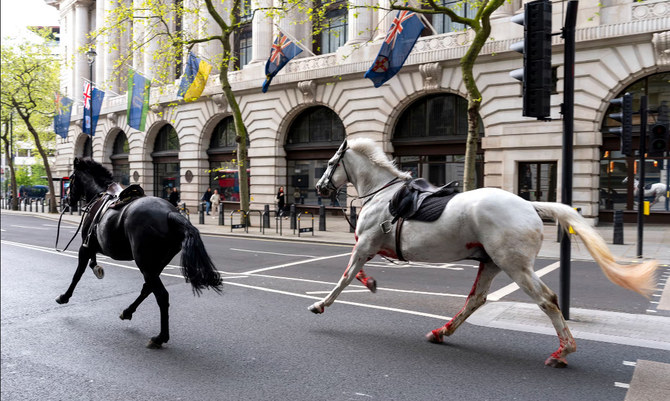
- Two horses ran along busy roads, dodging buses, taxis and other traffic
- Both were wearing saddles and bridles, with one apparently covered in blood on its chest and forelegs
LONDON: Four people were taken to hospital after spooked army horses broke loose during morning exercises in central London and galloped through the streets at rush hour, the army and emergency services said.
Photos and video posted on social media by British news outlets showed two horses running along busy roads, dodging buses, taxis and other traffic.
Both were wearing saddles and bridles, with one apparently covered in blood on its chest and forelegs.
A number of prestigious army cavalry regiments have stables in the British capital and horses are a regular sight around government buildings on Whitehall, Buckingham Palace, The Mall and in nearby Hyde Park.
London Ambulance Service said it was called at 8:25 am (0725 GMT) to reports of a person being thrown from a horse on Buckingham Palace Road.
No details were released on the injured people or the exact circumstances of their injuries.
The driver of a Mercedes car told LBC radio he had been waiting outside a hotel in Buckingham Palace Road when he felt something smash into his car.
He said he saw three or four horses near the vehicle, and that an army rider had been thrown off and injured.
One horse also reportedly crashed into a parked double-decker tour bus, smashing the windscreen.
One commuter shared a video on social media platform X, formerly Twitter, showing a black horse and a white horse being pursued by a black car.
“It was the street from Tower Bridge toward Limehouse Tunnel... just running past cars and an unmarked Range Rover following them,” the person said.
Up to seven horses initially got loose, Britain’s domestic Press Association news agency reported, with police working with the army to recapture them.
The army said in a statement that “a number of military working horses became loose during routine exercise this morning.”
“All of the horses have now been recovered and returned to camp. A number of personnel and horses have been injured and are receiving the appropriate medical attention,” it added.
Two of the horses were recaptured by the City of London Police, which polices the Square Mile financial district.
It said officers had contained two animals and that “an army horse box had collected the horses and transported them to veterinary care.”



